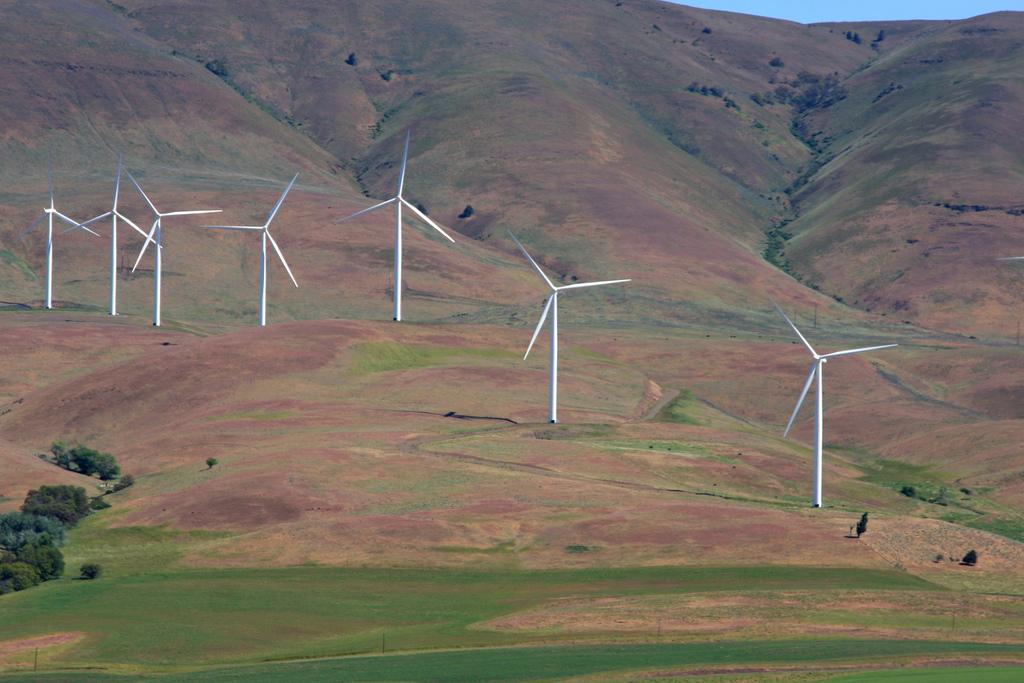
Under House Bill 2021, the state's two largest power providers will need to transition from fossil fuels to more renewable energy sources.
Amelia Templeton / OPB
Oregon’s power grid will largely eliminate carbon emissions by 2040 under a bill that got final approval by state lawmakers on Saturday, setting one of the nation’s most ambitious goals for reducing greenhouse gas emissions from the electricity sector.
House Bill 2021 passed the Senate on a 16-12 vote after passing the House the day before and now heads to Gov. Kate Brown.
The vote granted passage to one of several major bills lawmakers had yet to take up, on what is likely to be the Legislature’s final day of action. It came as Oregonians were bracing for a record-breaking heat wave that has officials scrambling to open cooling centers and issue urgent warnings about wildfire danger.
“Look at the temperatures expected this weekend, and ongoing and prolonged drought,” state Rep. Pam Marsh, D-Ashland, one of the bill’s chief proponents, said on the House floor on Friday. “What I know when I look at that is if we fail to address the underlying conditions, we are just going to be back in this Capitol, year after year, trying to help communities out of disastrous situations.”
HB 2021 sets a timetable by which Oregon’s two major power companies, Portland General Electric and Pacific Power, must eliminate emissions associated with the electricity they provide. Five “electricity service suppliers” in the state also would face regulation, though their emissions are tiny compared to the big utilities.
While at least 17 other states have similar goals, Oregon’s timeline of getting power suppliers to zero emissions by 2040 is more ambitious than nearly all. In addition to that end date, regulated entities would be required to submit plans to reduce emissions by 80% from a baseline amount by 2030 and 90% by 2035.
The bill also:
- bans expansion or new construction of power plants that burn natural gas or other fossil fuels
- sets labor standards for any large-scale renewable energy projects built in the state
- includes $50 million in grants for community renewable energy projects in cities other than Portland, which has its own fund for such projects
- allows cities in Oregon to create so-called “green tariffs,” where they agree to pay utilities more money for power from a cleaner mix of sources in order to meet their own climate goals
- requires power companies to consider input from low-income ratepayers, environmental justice communities, federally recognized tribes and others as they develop strategies for reducing emissions.
While heralded by environmental groups, advocacy organizations and organized labor, HB 2021 is less sweeping than proposals for reducing greenhouse gas emissions that Democrats had pushed in recent sessions.
Bills to create a cap-and-trade system in Oregon would have mandated reductions in not just the power sector, but also in manufacturing and transportation. But those bills, introduced in the 2019 and 2020 sessions, led Republicans to walk away from the Capitol, effectively killing the proposal. Gov. Kate Brown subsequently signed an executive order aiming to reduce emissions in many areas, but with little impact on electricity.
According to the Oregon Department of Environmental Quality, emissions from electricity accounted for 30% of the state’s greenhouse gas emissions in 2019. The entities regulated under HB 2021 are responsible for the vast majority of that, but some providers are left untouched.
Republican lawmakers voted almost universally against HB 2021, arguing that it did not do enough to ensure renewable energy products are built in Oregon and suggesting that eliminating carbon emissions could leave the state’s power grid vulnerable.
“It sounds good on the 5 o’clock news, but it will not help on the ground,” said state Sen. Lynn Findley, R-Vale, who argued that land-use regulations would block renewable energy projects in his eastern Oregon district.
While Findley said his input on HB 2021 was taken into consideration, some Republicans complained their ideas were not welcome in crafting the bill.
“I’ve arguably been involved in more public hearings with regards to cap and trade and carbon reduction than any other member on this floor, and I was not in those rooms, having those conversations,” said state Rep. David Brock Smith, R-Port Orford, one of the bill’s most vocal critics. “I was not invited.”
But while some industry lobbyists opposed the bill, it did not generate the more widespread backlash that cap and trade engendered. Both PGE and Pacific Power supported the bill, in part because it will allow them to be temporarily exempted from new requirements if they increase rates by more than 6% a year or threaten the reliability of the power grid.
The power companies already have goals for reducing their carbon emissions, though, with current technology, there are questions about how they could eliminate the final 10% to 20% of fossil fuels and still provide reliable power.
Senators on both sides of the aisle suggested on Saturday that is certain to change in the coming decades.
“If we didn’t do this bill today, we would still be 100% green by 2045,” Findley said. “Our [investor-owned utilities] are moving in that direction.”
Beyer, a former member of the state’s Public Utility Commission and self-described energy wonk, agreed, arguing that the fast-declining costs of renewable energy are making it desirable around the country.
“Probably if we did nothing the same thing would happen,” he said, “but this paves the way.”



